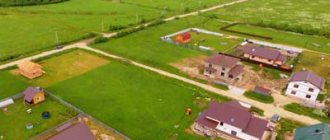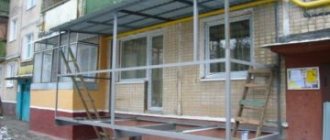The post-war period in the history of the USSR, among other things, is characterized by the active development of housing construction. Then the country's leadership faced a difficult task - providing the population with housing. In many ways, it has been accomplished and millions of Soviet families have received comfortable apartments. However, the bet was made precisely on the number of square meters being built. The quality of the housing built could not be said in a positive way.
In our time, this has led to the fact that most of the residential buildings that were built during the early and post-war USSR are already outdated, both physically and morally. At the same time, a significant part of apartment buildings not only require major repairs, for which, in fact, the corresponding program was created, but also become completely uninhabitable, showing signs of disrepair.
Within the framework of this article, we will consider the very definition of the concept of “emergency housing” and the criteria by which a house can be recognized as unsafe, as well as the procedure for recognizing an apartment building as dangerous for the future residence of residents.
The legislative framework
According to various estimates, about 1 million people in our country live in apartment buildings, which are, in fact, dangerous to stay in.
The depreciation of the housing stock is approximately 5-7% of its total quantity. At the same time, according to data for 2021, the highest percentage of housing wear and tear is in Yakutia. 16.51% of houses there are unsuitable for living (according to the Ministry of Construction of the Russian Federation). Attention! Since the accident rate of apartment buildings is recognized only as a result of an appropriate examination, the Ministry of Construction in its statistical reports takes into account them only with an already assigned status.
In reality, the number of unsuitable housing is much higher. It should be borne in mind that these statistics reflect only emergency housing. There are much more dilapidated houses, and they, in turn, will also become uninhabitable over time.
This problem did not arise overnight. The process of deterioration of the housing stock in Russia has become widespread quite a long time ago. In this regard, back in 2007, the Parliament of the Russian Federation adopted the federal law “On the Fund for Assistance to the Reform of Housing and Communal Services” No. 185-FZ.
This legal act, in fairly general terms, regulates issues related to the creation of a special fund that accumulates budget funds that are allocated for purposes related to the management of the housing stock in the Russian Federation.
In particular, it is through these funds that emergency housing is demolished and new housing is purchased for resettled residents. In addition, the law regulates the procedure for regions to receive funds within the framework of resettlement plans created by the latter. This made it possible to align the process of reforming housing and communal services throughout the country in different regions of the country.
In general, this legal act, for the most part, determines the procedure for interdepartmental interaction in terms of allocating funds for various programs in the housing and communal services sector, where the resettlement of emergency housing is a priority today.
The very procedure for declaring an apartment building unsuitable for permanent residence is regulated by the relevant Regulation, which was approved by Decree of the Government of the Russian Federation No. 47 of January 28, 2006.
This document introduces the concept of “emergency housing” into legislation, defines the criteria for recognizing an apartment building as such, and also regulates the corresponding procedure.
In addition, issues related to the resettlement of emergency housing stock are regulated by separate norms of the Housing Code of the Russian Federation. So, for example, Article 32 of the Housing Code of the Russian Federation determines the forms of ensuring the housing rights of citizens during the resettlement of apartment buildings.
The technical characteristics of unsuitable housing, which the interdepartmental commission is guided by, are reflected in the Methodological Manual MKD 2-04.2004.
What Percentage Of House Wear Is Considered Unsafe?
The dilapidated condition of a building is a condition in which the structures, foundation (building as a whole), as a result of high physical wear and tear, no longer meet the specified operational requirements (“Methodological recommendations for protecting the rights of participants in the reconstruction of residential buildings of various forms of ownership” (approved by Order of the State Construction Committee of the Russian Federation dated November 10. 1998N
4. Dilapidated residential building - a residential building with physical wear and tear, in which its strength and deformation characteristics are equal to or lower than the maximum permissible characteristics established by regulatory documents for current loads and operating conditions.
Emergency housing (read more…)
What does housing in disrepair mean?
The condition of the housing stock is determined by its technical characteristics. It is important to note that when determining the accident rate criterion, the general wear and tear of the house is taken into account, and not its individual structural elements.
For example, if a building has a significant percentage of roof wear, but its other elements are in good condition, then such a house cannot be recognized as requiring demolition . To give it this status, it must meet certain criteria.
Accident criteria
To determine the set of criteria by which a building may be considered unfit for further habitation, it is necessary to refer to the current legislation. In particular, they are contained in the Regulations approved by Decree of the Government of the Russian Federation No. 47 of January 28, 2006, as well as the Methodological Manual MKD 2-04.2004.
Thus, having analyzed the content of these documents, we can identify the following criteria for the accident rate of MKD:
- violation of the integrity or deformation of the structural elements of the building. The latter in construction include floors, as well as load-bearing walls;
- destruction or deformation of the building foundation;
- damage caused by a fire or other man-made cause that cannot be eliminated during a major overhaul of the building.
It is impossible to identify these criteria without conducting an appropriate examination.
In addition, even a house that is in technically satisfactory condition can be considered unsafe. The basis for declaring it unfit for habitation is the location of the building in a dangerous zone , the territory of which is exposed to the risks of natural disasters. For example, if the building is located in an area of flooding or an avalanche (mudflow).
How is it different from the old one?
The concept of “dilapidated housing” as such is not considered in the legislation, which regulates the procedure for demolition of housing of inadequate quality. In this regard, there are certain problems with determining the status of such MKDs.
To understand by what signs the dilapidation of a residential building can be determined, you need to refer to the Methodological Manual MKD 2-04.2004.
Thus, according to this document, housing is recognized as dilapidated if the physical wear and tear of the building is:
- for wooden houses - more than 65%;
- for stone MKD – more than 70%.
At the same time, an important feature of such buildings is that, despite the unsatisfactory living conditions, there is no danger for the residents themselves, since the level of wear and tear is insufficient for the collapse of the building and its ceilings.
Important! The main difference between emergency housing and dilapidated housing is not the comfort of living or even the percentage of wear and tear as such, but the criterion for the possibility or impossibility of further living in it due to the danger of destruction of the entire structure.
Law
On the territory of the Russian Federation there is a certain list of legislative acts that regulate the procedure and conditions for recognizing residential buildings as dilapidated and unsafe in 2021:
- Civil Code of the Russian Federation. It contains a list of general terms and concepts;
- Housing Code. It contains a list of measures to recognize residential buildings as unsafe;
- Regulation No. 47. It is this legislative act that contains complete and detailed information for each individual case. It also contains information regarding in which cases it is subject to demolition, and in which the situation can be corrected through reconstruction or repair work.
State resettlement program
In order to speed up the housing and communal services modernization program in terms of resettling citizens from housing that was recognized as unsafe, President of the Russian Federation V.V. Putin signed Decree No. 204 of May 7, 2021. According to it, the authorities began implementing the corresponding Federal project.
As part of it, federal authorities are creating legislative mechanisms for the resettlement of citizens from unsuitable residential premises. This project is expected to last until April 2024. The goal of the program is to resettle at least 530 thousand people with a reduction in the share of emergency premises by 9.65 million square meters.
Step-by-step instruction
- Submitting an application in writing. In the application form, it is necessary to indicate the applicant’s data, the exact address of the location of the object, a description of the destruction and damage, and a list of evidentiary documents. The applicant must sign. If the appeal is collective, then all applicants sign the written appeal.
- Creation of a commission that will determine the status of the object and issue an act of examination. The conclusion is drawn up in two copies , one of which is given to the applicants. Five days are given to make a decision.
- Facilities recognized as emergency are subject to resettlement within fourteen days. In reality, this procedure takes up to several months.
The procedure for recognizing an accident
The procedure for recognizing an apartment building as unsafe is determined by the relevant Regulations approved by Decree of the Government of the Russian Federation No. 47. According to this document, several stages should be distinguished in recognizing housing as unsuitable for citizens to live in. Let's look at each of them in detail.
Establishing the fact of unsuitability for residence
The fact of an accident itself must be established by an appropriate examination. It should be noted that this requires the initiative of one of the interested parties.
Thus, the initiators of recognition can be:
- a municipality that manages housing stock that is in unsatisfactory condition;
- Rospotrebnadzor authorities within the framework of requests received to them
- fire inspection;
- residents of the house.
In practice, most often the initiators are the residents of the house. To start the process, they need to collectively submit an appeal to the municipal administration. Based on the results of consideration of this appeal, a decision is made to form an interdepartmental commission that will conduct an examination of the technical condition of the apartment building. Based on the results of the commission’s work, a conclusion is made on recognizing the house as unsafe or on the impossibility of assigning this status to it.
If the condition of the house is considered inadequate, then the residents are resettled within a few months , and the building itself becomes subject to demolition.
Separately, mention should be made of the possibilities for relocating architectural monuments. If a building has a protected status, then it cannot be demolished as such. In this regard, its reconstruction is being carried out. The latter is carried out both with the involvement of budget funds (if the house is included in the corresponding regional or federal program) and with the involvement of funds from the owners of the building.
Collection of documents
When submitting an application to the municipality, residents must provide the following package of documents:
- Statement. The document is signed by all interested owners of residential premises.
- Copies of citizens' passports.
- Title documents for residential premises. Certificates of ownership and extracts from the Unified State Register serve as title documents.
- Expert opinion. If an examination of the condition of the load-bearing structures of the apartment building was previously carried out, then its conclusion must be attached to the application.
Reference! This list is not exhaustive. In practice, the interdepartmental commission may request other documents to conduct a full assessment.
Inclusion in the house demolition register
Information about apartment buildings that are subject to demolition is entered into the appropriate schedules. Thus, passports of regional resettlement programs and schedules are entered into the federal register. The information contained in it can be found on the Housing and Communal Services Reform portal.
In addition, demolition schedules are publicly available on the websites of regional authorities.
What documents are needed?
In order for a house to be recognized as unsafe, the following documents are needed:
- statement from people living in this house;
- copies of their passports as citizens of the Russian Federation;
- title documents;
- expert opinion;
- complaints about poor and harmful living conditions.
If a house is deemed unsafe, it must be demolished. Information about the demolition date of the house can be obtained from the local administration or department of architecture.
Also, if the owner is not provided with new housing, he may be offered compensation. If the owner expresses a desire, he can demand it from the state. They offer him a ransom price. If the homeowner does not agree with this amount, then the issue can be resolved in court. If he is offered housing with a larger area, he must pay for the additional square meters.
If a person lived on the basis of a social tenancy agreement, he will be offered other housing. In this case, it is impossible to receive compensation.
Residents' rights
Current legislation suggests that instead of housing in a dilapidated building, a citizen is given a new apartment. At the same time, certain requirements are imposed on the new residential premises. Thus, apartments must be provided with sanitary communications, they must have a clean finish . In other words, housing must be suitable for living without additional material investments on the part of the resettled person.
In addition, it is established that the new apartment must have an equal or slightly larger area than it was previously. It is also possible to provide housing with a significantly larger area, but subject to additional payment by the citizen.
As for the location of the apartment for relocation, it must be located within the same municipality in which the old housing was located.
The owners of the residential premises of the house being demolished have the right to independently choose the form in which their rights will be ensured. They can choose to move to a new comfortable apartment or receive monetary compensation.
Tenants of municipal apartments can only count on moving to new housing. There is no option for them to choose monetary compensation.
Where to go
ATTENTION! In order for a house to be officially recognized as unsafe and unfit for habitation, its residents or tenants must contact special departments that are authorized to create a special commission.
The commission conducts a detailed study to determine whether the building complies with all the standards and requirements that apply to it under the law:
- Local administration employees.
- Housing inspection specialists.
- Employees of Rospotrebnadzor.
- Ministry of Emergency Situations.
There are such concepts as a dilapidated and dilapidated house. These terms have significant differences.
Ministry of Housing and Communal Services - official websites
Eviction from service residential premises (housing)
This online platform is aimed at popularizing the implementation of resource-saving technologies and conducting awareness-raising work in the field of energy efficiency. In addition, visitors to the portal can take advantage of the services of a distance learning center on organizing energy-efficient major renovations, where internationally recognized experts in the field of energy saving and energy efficiency increase share their experience.
In addition, the portal contains a register of experts in energy-efficient major renovations of apartment buildings who have successfully passed testing and completed all practical tasks on this topic.
Let us note that any visitor to the site can test his knowledge in matters of energy-efficient major repairs, and based on its results, he can also be included in the specified register. Moscow Pavel Zharov. In total, today the register includes 12 experts in energy-efficient major renovations of apartment buildings. You can take a test on energy-efficient major renovations of apartment buildings here.
Moscow, st. Sharikopodshipnikovskaya, building 5. All rights reserved. To My World.
Dilapidated housing is housing that is unfit for habitation. Arbitrage practice
Criteria for classifying housing as dilapidated Dilapidated condition of a building is a condition in which the building structures and the building as a whole are worn out: for stone houses - over 70%, wooden houses with walls made of local materials, as well as attics - over 65%, the main load-bearing structures are preserved strength sufficient to ensure the stability of the building, but the building no longer meets the specified operational requirements.
- After how many years is a house considered unsafe?
- What year are houses considered unsafe?
Many criteria and internal regulations do not give a clear idea of which houses are unsafe and which are not? The percentage of wear must be at least 70% . The figure is calculated using construction formulas and a calculator. However, in practice, this scheme does not always work.
What Percentage Of House Wear Is Considered Unsafe?
Residents of house No. 23 are faced with the problem of house failure. There were monthly power outages in the building that shorted out the wiring. Muddy brown water flowed from the taps. The walls in the basements were covered with mold and mildew, and residents felt high humidity in the apartments and entrance halls. The foundation was not credible. Experts have established that the MKD is gradually settling down, which in the future may lead to its collapse. These signs influenced the recognition of housing as unsafe. Apartment owners were promised new living spaces in the neighborhood.
There are also counter examples. Houses with up to 60% deterioration are ready to collapse. Residents complain about problems with ventilation, airflow, destruction of walls and dampness in the basement. Changes in the design strength make it possible to recognize such a house as unsafe.
Which houses are considered subject to demolition? (read more…)







